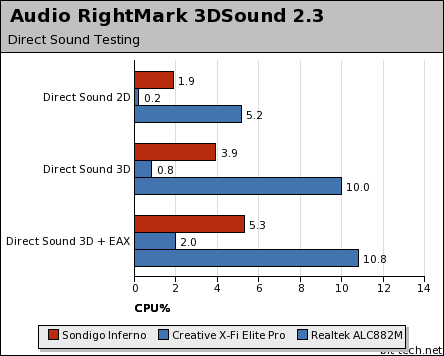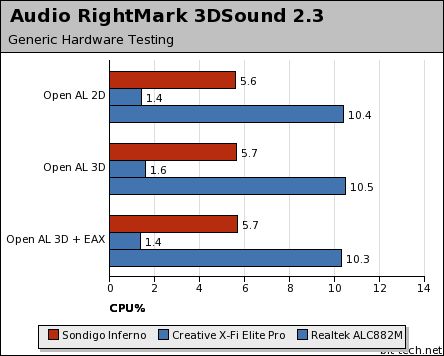
We understand that using simply Rightmark 3D Sound audio analyser to provide CPU usage results is somewhat limited, being as multiple cored CPUs are now horsepower rich and a few percent on the audio use is going to make, at most, only a few frames per second difference. However, we also feel that it is necessary to provide some comparative data alongside subjective testing in order to provide a reference in performance. Without getting into extremely complex audio analysis like analysing sine waves with oscilloscopes for the quality of a cards output, something no home user will ever have access to or do themselves, this is a useful comparison.
It’s also worth noting that recently it has been made public that Realtek’s ALC range does not render EAX 2.0 audio properly, so the results from EAX hardware testing on the ALC882M will be inaccurate for true EAX, but they will represent what is actually used on any system running the ALC(882) codec.
Driver Versions:


As you can see from the results the X-Fi offloads a significant quantity of audio processing from the CPU, whereas the Inferno does pretty well but still uses at most 1/20th of the total CPU cycles. The onboard ALC882M audio however uses twice as much as the Inferno and is pretty consistently in the 10% CPU area.
But having said all this, the X-Fi uses more memory and more background processes, so despite it using less CPU it uses more PC resources in the fuller sense so this rather negates any advantage there.
It’s also worth noting that recently it has been made public that Realtek’s ALC range does not render EAX 2.0 audio properly, so the results from EAX hardware testing on the ALC882M will be inaccurate for true EAX, but they will represent what is actually used on any system running the ALC(882) codec.
Driver Versions:
- Sondigo Inferno 7.1: 1.0.0.28, WDM: 5.10.1.8
- Creative X-Fi Elite Pro: 2.09.0001
- Realtek ALC882M: 5.10.00.5224


As you can see from the results the X-Fi offloads a significant quantity of audio processing from the CPU, whereas the Inferno does pretty well but still uses at most 1/20th of the total CPU cycles. The onboard ALC882M audio however uses twice as much as the Inferno and is pretty consistently in the 10% CPU area.
But having said all this, the X-Fi uses more memory and more background processes, so despite it using less CPU it uses more PC resources in the fuller sense so this rather negates any advantage there.

MSI MPG Velox 100R Chassis Review
October 14 2021 | 15:04








Want to comment? Please log in.